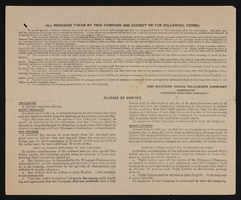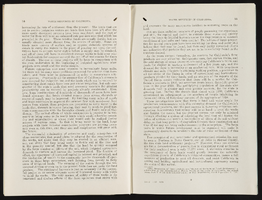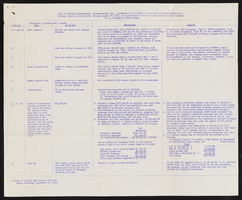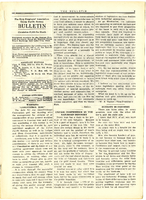Search the Special Collections and Archives Portal
Search Results

Interview with Charles Costa, February 13, 2009
Date
2009-02-13
Archival Collection
Description
Narrator affiliation: Public Health Service (USPHS), Environmental Protection Agency (EPA); Test Director, Los Alamos National Laboratory
Text
Sondra Cosgrove (Vote Nevada) oral history interview conducted by Magalena Martinez and Elia Del Carmen Solano-Patricio: transcript
Date
2023-01-20
Archival Collection
Description
From the Lincy Institute "Perspectives from the COVID-19 Pandemic" Oral History Project (MS-01178) -- Community organization interviews file.
Text
Audio recording clip of interview with Faye Todd by Claytee D. White, October 15, 1996
Date
1996-10-15
Archival Collection
Description
Part of an interview with Faye Todd by Claytee White on October 15, 1996. Todd discusses how she came to work for the Landmark and what it was like to work with entertainers.
Sound
Audio clip of an interview with Kenneth Fong by Lois goodall on February 22, 2014
Date
2014-02-22
Archival Collection
Description
Kenneth Fong reflects on growing up in Las Vegas and being the son of two successful and philanthropic community members, Wing and Lilly Fong. When Ken was born the family live in a modest home on 20th and Stewart. It was a close-knit neighborhood and era, kids played tag and roamed freely. When he entered third-grade, his parents moved their family to a newer subdivision near Rancho and West Charleston Avenue: the Scotch 80s. Their new custom home on Silver Avenue reflected Asian architecture and the family’s Chinese cultural heritage; it also included a pool and a small basketball court. Memories of the neighborhoods are distinct. He learned to be comfortable with his sister and he being the only Asian Americans in school at the time. He kept busy with community volunteering at Sunrise Hospital and tutoring younger children on the Westside among other high school activities. Ken speaks lovingly of his parents and their achievements, family outings to local venues such as Mount Charleston and Red Rock and to California, where they bought Chinese baked goods. His mother, Lilly was born into a large Chinese American family of ten children, each of whom achieved a college education. After her marriage to Wing, she moved to Las Vegas with plans to work as a teacher. Ken retells the story of her encounter with discrimination and overcoming that, and her trajectory to be the first Asian American elected the Nevada Board of Regents. His orphaned father, Wing, immigrated to the United Sates in 1939 to live with uncles. They worked as cooks in Las Vegas and established the first Las Vegas Chinese restaurant, Silver Café. Wing was merely thirteen years old and spoke no English. These were not to be obstacles. He would go on to graduate from Las Vegas High School, earn a college degree in business, have a successful career in commercial real estate and banking, building the notable Fong’s Garden. Ken calls his father his most influential mentor. Today Ken is also a successful in real estate management, active at Grace Presbyterian Church, involved in Rotary Club, and a proud father of two daughters.
Sound
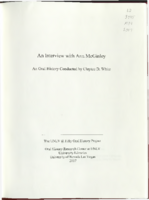
Transcript of interview with Ann McGinley by Claytee D. White, August 01, 2006
Date
2006-08-01
Archival Collection
Description
Ann McGinley grew up in Allentown, Pennsylvania, the third child in a family of four. Her mother was a homemaker and her father was a lawyer. It was because of her father that she became interested in civil rights. Ann attended college and majored in Spanish. She earned a master’s degree and taught in Spain for five years. Her brother and his wife were lawyers and she decided to go back to law school at the University of Pennsylvania. Ann did a two year clerkship for a federal judge, doing research and drafting opinions. She met her husband-to-be during this time and they mover to Minneapolis. Ann did commercial litigation and worked on a class action suit against the school system on behalf of the American Indian population. Her husband wanted to teach and was hired by Brooklyn Law School. Their first child was on the way and Ann studied for the bar in New Jersey. She then worked for a small firm in Labor and Employment Discrimination. A teaching job at Brooklyn Law School opened up and she worked part-time there for four or five years, meanwhile giving birth to two more children. It then seemed like the right time to make a career move, so Ann and her husband applied and were hired at Florida State in Tallahassee. After watching others being denied tenure and having experienced that denial themselves, they were ready to move on. A phone call from Carl Tobias inviting them to UNLV was followed up with interviews, and the McGinley’s made the move to Las Vegas. Ann and her family settled in Green Valley in 1999 during Carol Harter’s administration. Ann drafted the plan for a clinical program, which uses real clients to help train law students, and has helped build other programs for the law school. Ann now teaches employment law, employment discrimination, disabilities discrimination law, torts, and occasionally civil procedure. Her vision for the future of the law school is for it to continue with its social mission, and perhaps for a satellite campus to open at UNR. She is confident that the UNLV law school will continue to be a place where women can thrive.
Text

The Dunes Hotel tower under construction: photographic film
Date
1960 (year approximate) to 1986 (year approximate)
Archival Collection
Description
A view of the Dunes Hotel tower under construction. The famous sultan statue is visible in the foreground. The marquee is visible in the background advertising "Now in the Persian Room Vive Les Girls French Stage Spectacular 8:30 pm, 11:30 pm, 1:15 am" and "Persian Room All new direct from Paris Vive Les Girls! Produced by Danny Costello Star of the Ed Sullivan Show". The Dunes, which was themed after the Arabian Nights stories, opened on May 23, 1955 with 200 hotel rooms, located in several two-story buildings. From the time of its opening, the Dunes was known for the 35 foot tall fiberglass sultan statue that stood above its main entrance. In 1961, a 24-story, 250-room hotel tower, known as Diamond of the Dunes, was added to the northern part of the property, bringing the total number of rooms to 450. At the top of the tower was the Top O' the Strip restaurant and lounge. The tower was the tallest building in the state at the time. In 1979, the South Tower was added, expanding the hotel to 1300 rooms. A second casino in a separate, round building on the site opened in 1983 under the name Oasis Casino at The Dunes. In 1985, the sultan statue was moved to the golf course during renovations, and later caught fire, reportedly due to an electrical short. On November 17, 1992, the Dunes was sold to Wynn's company, Mirage Resorts, Inc., for $75 million. On January 26, 1993, the Dunes closed its doors for good. Steve Wynn bought the Dunes and started the redevelopment trend with the demolition of the 32-year-old North Tower. On October 27, 1993, the Dunes was demolished in a grand ceremony that involved major fireworks displays and the use of several "cannon blasts" from the English ship 'HMS Britannia' of Treasure Island Hotel and Casino. The 15-year-old South Tower was demolished 9 months later in July 1994, with no fanfare and minimal media attention. The Bellagio now stands in its place. The property is located at 3600 Las Vegas Boulevard South, Las Vegas, NV 89109.
Image
Pagination
Refine my results
Content Type
Creator or Contributor
Subject
Archival Collection
Digital Project
Resource Type
Year
Material Type
Place
Language
Records Classification

